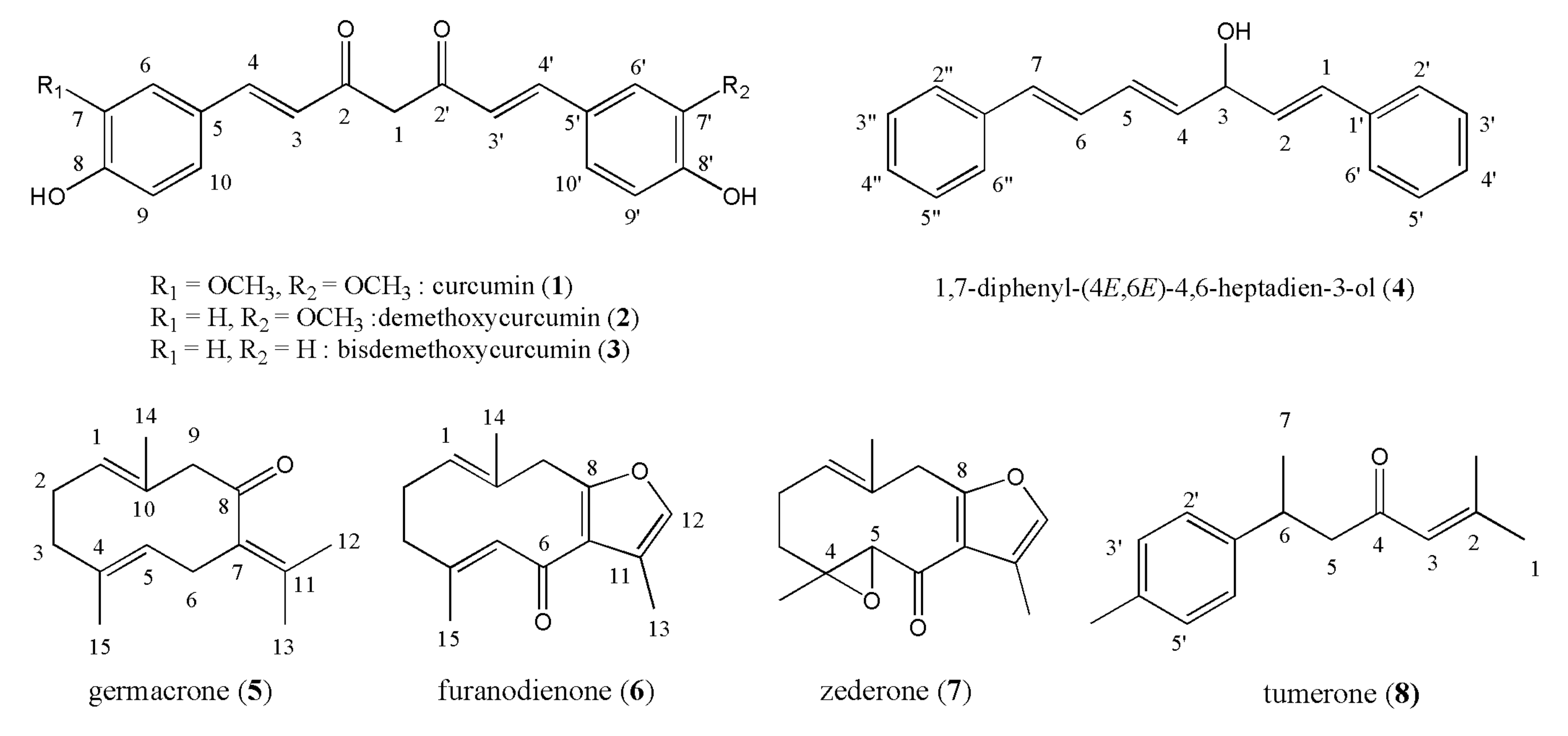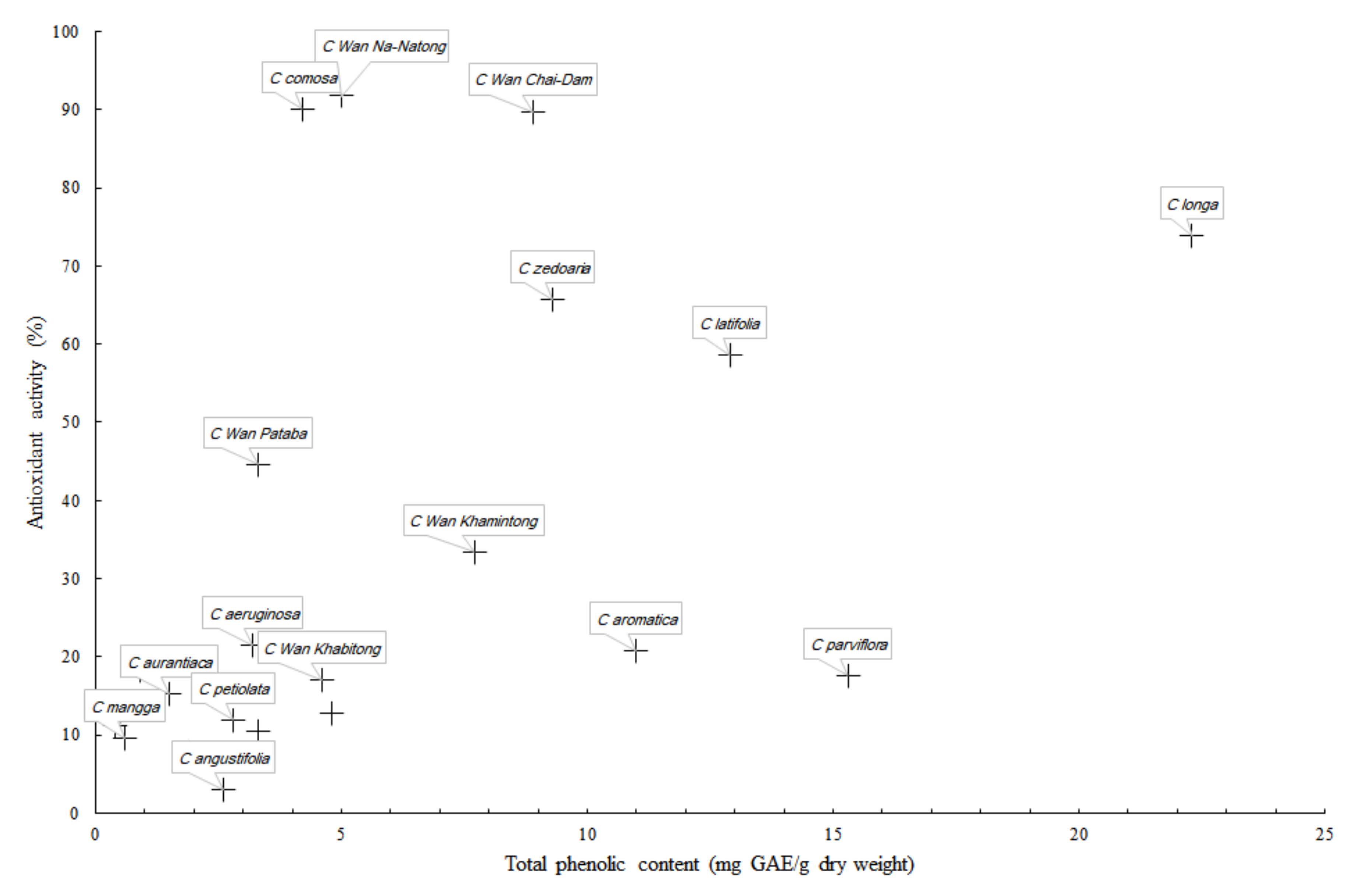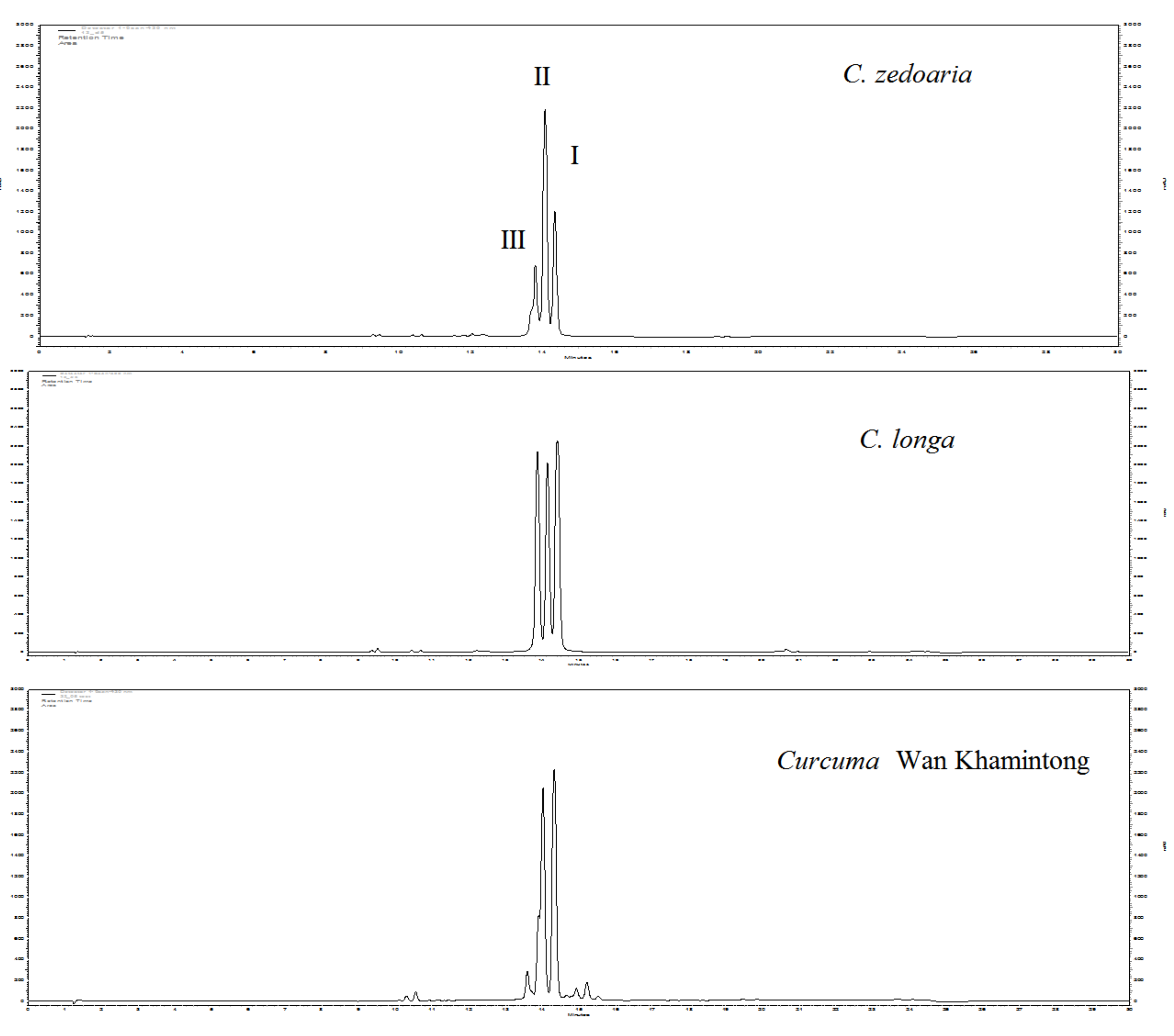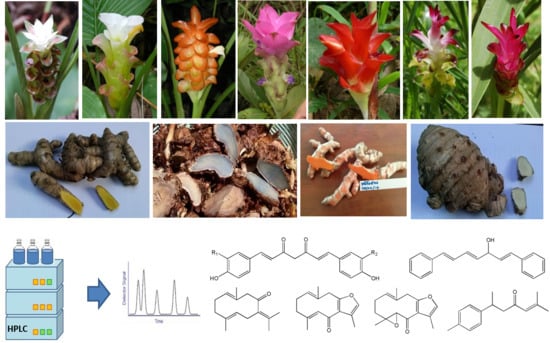Thai Curcuma Species: Antioxidant and Bioactive Compounds
Abstract
1. Introduction
2. Materials and Methods
2.1. Curcuma Species
2.2. Plant Materials and Extraction
2.3. Determination of Total Phenolic Contents
2.4. DPPH Radical Scavenging Assay
2.5. Isolation of Compounds
2.6. Validation of HPLC Analysis
2.7. Compositional Analysis of Curcuma Species
2.8. Statistical Analyses
3. Results and Discussion
3.1. Taxonomy of Curcuma Species
3.2. Total Phenolic Content and Antioxidant Activity
3.3. Isolation of Bioactive Curcuminoids and Sesquiterpenoids
3.4. Chemical Composition of 23 Curcuma Species
4. Conclusions
Supplementary Materials
Author Contributions
Funding
Acknowledgments
Conflicts of Interest
References
- Ravindran, P.N.; Nirmal, B.K.; Sivaraman, K. (Eds.) Tumeric—The Genus Curcuma; CRC Press: Boca Raton, FL, USA, 2007; p. 504. [Google Scholar]
- Leong-Skornickova, J.; Sida, O.; Jarolimova, V.; Sabu, M.; Fer, T.; Travnicek, P.; Suda, J. Chromosome numbers and genome size variation in Indian species of Curcuma (Zingiberaceae). Ann. Bot. Lond. 2007, 100, 505–526. [Google Scholar] [CrossRef] [PubMed]
- Chen, J.; Xia, N.; Zhao, J.; Chen, J.; Henny, R. Chromosome numbers and ploidy levels of Chinese Curcuma species. Hortic. Sci. 2013, 48, 525–530. [Google Scholar] [CrossRef]
- Burapan, S.; Kim, M.; Han, J. Curcuminoid demethylation as an alternative metabolism by human Intestinal microbiota. J. Agric. Food Chem. 2017, 65, 3305–3310. [Google Scholar] [CrossRef]
- Pinkaew, D.; Changtam, C.; Tocharus, C.; Thummayot, S.; Suksamrarn, A.; Tocharus, J. Di-O-demethylcurcumin protects SK-N-SH cells against mitochondrial and endoplasmic reticulum-mediated apoptotic cell death induced by Aβ25–35. Neurochem. Int. 2015, 80, 110–119. [Google Scholar] [CrossRef]
- Agarwal, N.B.; Jain, S.; Nagpal, D.; Agarwal, N.K.; Mediratta, P.K.; Sharma, K.K. Liposomal formulation of curcumin attenuates seizures in different experimental models of epilepsy in mice. Fundam. Clin. Pharmacol. 2013, 27, 169–172. [Google Scholar] [CrossRef]
- Habsah, M.; Amran, M.; Mackeen, M.M.; Lajis, N.H.; Kikuzaki, H.; Nakatani, N.; Rahman, A.A.; Ali, A.M. Screening of Zingiberaceae extracts for antimicrobial and antioxidant activities. J. Ethnopharmacol. 2000, 72, 403–410. [Google Scholar] [CrossRef]
- Singleton, V.L.; Rossi, J.A. Colorimetry of total phenolics with phosphomolybdic-phosphotungstic acid reagents. Am. J. Enol. Viticult. 1965, 16, 144–158. [Google Scholar]
- Uehara, S.I.; Yasua, I.; Akiyama, K.; Morita, H.; Takeya, K.; Itokawa, H. Diarylheptanoids from the rhizomes of Curcuma xanthorrhiza and Alpinia officinarum. Chem. Pharm. Bull. 1987, 35, 3298–3304. [Google Scholar] [CrossRef]
- Shibuya, H.; Hamamoto, Y.; Cai, Y.; Kitagawa, I. A reinvestigation of the structure of zederone, a furanogermacrane-type sesquiterpene from zedoary. Chem. Pharm. Bull. 1987, 35, 924–927. [Google Scholar] [CrossRef]
- Firman, K.; Kinoshita, T.; Itai, A.; Sankawa, U. Terpenoids from Curcuma heyneana. Phytochemistry 1988, 27, 3887–3891. [Google Scholar] [CrossRef]
- Dekebo, A.; Dagne, E.; Hansen, L.K.; Gautun, O.R.; Aasen, A.J. Crystal structures of two furanosesquiterpenes from Commiphora sphaerocarpa. Tetrahed. Lett. 2000, 41, 9875–9878. [Google Scholar] [CrossRef]
- Barrero, A.F.; Herrador, M.M.; Lopez-Perez, J.; Arteaga, J.F.; Catalan, J. New pathways in transannular cyclization of germacrone [germacra-1(10),4,7(11)-trien-8-one]: Evidence regarding a concerted mechanism. Org. Lett. 2009, 11, 4782–4785. [Google Scholar] [CrossRef]
- Sukari, M.A.; Wah, T.S.; Saad, S.M.; Rashid, N.Y.; Rahmani, M.; Lajis, N.H.; Hin, T.Y.Y. Bioactive sesquiterpenes from Curcuma ochrorhiza and Curcuma heyneana. Nat. Prod. Res. 2010, 24, 838–845. [Google Scholar] [CrossRef] [PubMed]
- Kader, M.G.; Habib, M.R.; Nikkon, F.; Yeasmin, T.; Rashid, M.A.; Rahman, M.M.; Gibbons, S. Zederone from the rhizomes of Zingiber zerumbet and its anti-Staphylococcal activity. Lat. Am. Caribb. Bull. Med. Arom. Plants 2010, 9, 63–68. [Google Scholar]
- Lee, J.H.; Choung, M.G. Determination of curcuminoid colouring principles in commercial foods by HPLC. Food Chem. 2011, 124, 1217–1222. [Google Scholar] [CrossRef]
- Paramasivam, M.; Poi, R.; Banerjee, H.; Bandyopadhyay, A. High-performancethin layer chromatographic method for quantitative determination of curcuminoids in Curcuma longa germplasm. Food Chem. 2009, 113, 640–644. [Google Scholar] [CrossRef]
- Péret-Almeida, L.; Cherubino, A.P.F.; Alves, R.J.; Dufossé, L.; Glória, M.B.A. Separation and determination of the physico-chemical characteristics of curcumin, demethoxycurcumin and bisdemethoxycurcumin. Food Res. Int. 2005, 38, 1039–1044. [Google Scholar] [CrossRef]
- Bos, R.; Windono, T.; Woerdenbag, H.J.; Boersma, Y.L.; Koulman, A.; Kayser, O. HPLC-photodiode array detection analysis of curcuminoids in Curcuma species indigenous to Indonesia. Phytochem. Anal. 2007, 18, 118–122. [Google Scholar] [CrossRef]
- Balaji, S.; Chempakam, B. Toxicity prediction of compounds from turmeric (Curcuma longa L). Food Chem. Toxicol. 2010, 48, 2951–2959. [Google Scholar] [CrossRef]
- Makabe, H.; Maru, N.; Kuwabara, A.; Kamo, T.; Hirota, M. Anti-inflammatory sesquiterpenes from Curcuma zedoaria. Nat. Prod. Res. 2006, 20, 680–685. [Google Scholar] [CrossRef]
- Liao, Q.; Qian, Z.; Liu, R.; An, L.; Chen, X. Germacrone inhibits early stages of influenza virus infection. Antivir. Res. 2013, 100, 578–588. [Google Scholar] [CrossRef] [PubMed]
- Lu, J.J.; Dang, Y.Y.; Huang, M.; Xu, W.S.; Chen, X.P.; Wang, Y.T. Anti-cancer properties of terpenoids isolated from Rhizoma curcumae—A review. J. Ethnopharmacol. 2012, 143, 406–411. [Google Scholar] [CrossRef] [PubMed]



| Compounds | Accuracy 1 | Linearity | Correlation Coefficient (R²) | LOD (mM) | LOQ (mM) |
|---|---|---|---|---|---|
| Curcumin (1) | 104.8 ± 7.9 | y = 56,277,482x + 476,424 | 0.9951 | 0.0081 | 0.0245 |
| Demethoxycurcumin (2) | 101.0 ± 7.9 | y = 50,455,350x + 56,885 | 0.9997 | 0.0020 | 0.0061 |
| Bisdemethoxycurcumin (3) | 96.5 ± 16.2 | y = 54,929,237x + 369,859 | 0.9964 | 0.0069 | 0.0209 |
| 1,7-diphenyl-(4E,6E)-4,6-heptadien-3-ol (4) | 106.9 ± 11.6 | y = 28,237,427x + 612,834 | 0.9963 | 0.0125 | 0.0377 |
| Germacrone (5) | 97.5 ± 16.6 | y = 3,051,741x + 22,600 | 0.9977 | 0.0110 | 0.0333 |
| Furanodienone (6) | 101.9 ± 6.8 | y = 8,043,402x − 10,111 | 0.9999 | 0.0020 | 0.0060 |
| Zederone (7) | 99.9 ± 5.1 | y = 5,130,378x + 25,981 | 0.9999 | 0.0026 | 0.0080 |
| ar-Turmerone (8) | 98.5 ± 15.0 | y = 35,723,577x + 423,877 | 0.9962 | 0.0125 | 0.0379 |
| Curcuma Species | Extraction Yield (%) | Total Phenolic Content (mg GAE/g Dry Weight) | Antioxidant Activity (%) 1 |
|---|---|---|---|
| Curcuma Wan Ma-Leung | 6.5 ± 0.4 | 0.9 ± 0.0 | 18.2 ± 0.3 |
| Curcumamangga | 6.9 ± 0.3 | 0.6 ± 0.3 | 9.6 ± 0.5 |
| Curcuma Wan Ma-Hor | 8.9 ± 0.2 | 0.5 ± 0.1 | 13.2 ± 0.5 |
| Curcuma Wan Khamin-Dam | 13.5 ± 0.2 | 3.9 ± 0.4 | 20.4 ± 0.4 |
| Curcuma Wan Rang- Jud | 6.3 ± 0.3 | 0.4 ± 0.1 | 11.2 ± 0.2 |
| Curcumaaeruginosa | 8.6 ± 0.2 | 3.2 ± 0.3 | 21.5 ± 0.3 |
| Curcuma comosa | 16.8 ± 0.3 | 4.2 ± 0.1 | 90.0 ± 0.3 |
| Curcuma Wan Kanta-Mala | 12.0 ± 1.0 | 4.8 ± 0.1 | 12.7 ± 0.3 |
| Curcumaaurantiaca | 11.9 ± 0.1 | 1.5 ± 0.1 | 15.2 ± 0.4 |
| Curcumaaromatica | 18.5 ± 0.3 | 11.0 ± 0.2 | 20.8 ± 0.1 |
| Curcuma latifolia | 20.3 ± 0.2 | 12.9 ± 0.3 | 58.6 ± 0.0 |
| Curcumazedoaria | 8.5 ± 0.6 | 9.3 ± 0.7 | 65.7 ± 0.2 |
| Curcumalonga | 21.6 ± 0.5 | 22.3 ± 2.4 | 73.9 ± 0.1 |
| Curcumaparviflora | 11.4 ± 0.5 | 15.3 ± 1.2 | 17.5 ± 0.5 |
| Curcumaangustifolia | 3.2 ± 0.3 | 2.6 ± 0.3 | 3.0 ± 0.2 |
| Curcuma Wan Khabitong | 11.7 ± 0.1 | 4.6 ± 0.1 | 17.0 ± 0.1 |
| Curcuma Wan Pataba | 5.8 ± 0.2 | 3.3 ± 0.1 | 44.5 ± 0.8 |
| Curcuma Wan Kortong | 8.4 ± 0.5 | 3.3 ± 0.1 | 10.4 ± 0.4 |
| Curcuma Wan Na-Natong | 3.7 ± 0.2 | 5.0 ± 0.1 | 91.8 ± 0.6 |
| Curcumapetiolata | 5.5 ± 0.1 | 2.8 ± 0.4 | 11.8 ± 0.4 |
| Curcuma Wan Khamin-Khao-Padtalod | 6.2 ± 0.3 | 1.9 ± 0.8 | 7.7 ± 0.2 |
| Curcuma Wan Chai-Dam | 3.9 ± 0.2 | 8.9 ± 0.2 | 89.8 ± 0.6 |
| Curcuma Wan Khamintong | 8.6 ± 0.2 | 7.7 ± 1.3 | 33.3 ± 0.7 |
| Curcuma Species | 1 | 2 | 3 |
|---|---|---|---|
| Curcuma Wan Ma-Leung | 5.2 ± 0.1 | 4.1 ± 0.0 | ND 1 |
| Curcuma Wan Ma-Hor | ND | 0.2 ± 0.0 | ND |
| Curcuma aeruginosa | 35.5 ± 0.7 | 107.2 ± 1.0 | ND |
| Curcumaaurantiaca | 3.2 ± 0.0 | 6.5 ± 0.0 | ND |
| Curcuma aromatica | 24.3 ± 0.1 | 112.5 ± 1.0 | ND |
| Curcuma zedoaria | 72.3 ± 0.6 | 201.5 ± 1.5 | 28.2 ± 0.8 |
| Curcuma longa | 304.9 ± 0.1 | 189.2 ± 0.4 | 158.8 ± 0.7 |
| Curcuma Wan Khabitong | 10.2 ± 0.1 | 6.6 ± 0.0 | ND |
| Curcuma Wan Kortong | 0.1 ± 0.0 | 1.8 ± 0.0 | ND |
| Curcuma Wan Khamintong | 47.2 ± 0.1 | 37.1 ± 0.1 | 8.0 ± 0.0 |
| Curcuma Species | Sesquiterpenoids (mg/g) 1 | |||
|---|---|---|---|---|
| 5 | 6 | 7 | 8 | |
| Curcuma Wan Ma-Leung | 42.6 ± 0.9 | ND 2 | ND | ND |
| Curcuma Wan Ma-Hor | 47.5 ± 0.7 | 4.0 ± 0.0 | 6.6 ± 0.2 | ND |
| Curcuma Wan Khamin-Dam | 126.5 ± 0.3 | 18.5 ± 0.1 | ND | ND |
| Curcuma aeruginosa | ND | 3.1 ± 0.0 | ND | ND |
| Curcuma comosa | 31.1 ± 0.2 | 81.0 ± 0.9 | 37.6 ± 0.2 | ND |
| Curcuma Wan Kanta-Mala | 106.9 ± 0.4 | 15.7 ± 0.1 | ND | ND |
| Curcuma aurantiaca | 36.5 ± 0.4 | 15.4 ± 0.5 | 8.6 ± 0.1 | 4.9 ± 0.0 |
| Curcuma aromatica | 73.7 ± 2.8 | 4.7 ± 0.0 | 33.2 ± 0.6 | ND |
| Curcuma latifolia | 56.2 ± 0.3 | 73.3 ± 1.1 | 61.3 ± 0.1 | ND |
| Curcuma zedoaria | 7.5 ± 0.1 | 15.5 ± 0.4 | 3.3 ± 0.0 | 53.9 ± 0.2 |
| Curcuma longa | ND | ND | ND | 78.4 ± 0.2 |
| Curcuma parviflora | ND | 3.6 ± 0.1 | ND | ND |
| Curcuma angustifolia | 285.3 ± 0.6 | ND | ND | ND |
| Curcuma Wan Khabitong | 6.8 ± 0.1 | ND | ND | 4.4 ± 0.2 |
| Curcuma Wan Patab | 31.2 ± 0.3 | 2.5 ± 0.0 | ND | 0.2 ± 0.0 |
| Curcuma Wan Kortong | ND | ND | ND | 3.5 ± 0.2 |
| Curcuma Wan Na-Natong | 144.3 ± 2.8 | 47.1 ± 0.4 | 13.2 ± 0.1 | ND |
| Curcuma petiolata | ND | ND | ND | 0.4 ± 0.0 |
| Curcuma Wan Khamin-Khao-Padtalod | ND | ND | ND | 17.6 ± 0.1 |
| Curcuma Wan Chai-Dam | ND | 65.1 ± 0.2 | 13.5 ± 0.3 | ND |
| Curcuma Wan Khamintong | ND | ND | ND | 4.6 ± 0.0 |
© 2020 by the authors. Licensee MDPI, Basel, Switzerland. This article is an open access article distributed under the terms and conditions of the Creative Commons Attribution (CC BY) license (http://creativecommons.org/licenses/by/4.0/).
Share and Cite
Burapan, S.; Kim, M.; Paisooksantivatana, Y.; Eser, B.E.; Han, J. Thai Curcuma Species: Antioxidant and Bioactive Compounds. Foods 2020, 9, 1219. https://doi.org/10.3390/foods9091219
Burapan S, Kim M, Paisooksantivatana Y, Eser BE, Han J. Thai Curcuma Species: Antioxidant and Bioactive Compounds. Foods. 2020; 9(9):1219. https://doi.org/10.3390/foods9091219
Chicago/Turabian StyleBurapan, Supawadee, Mihyang Kim, Yingyong Paisooksantivatana, Bekir Engin Eser, and Jaehong Han. 2020. "Thai Curcuma Species: Antioxidant and Bioactive Compounds" Foods 9, no. 9: 1219. https://doi.org/10.3390/foods9091219
APA StyleBurapan, S., Kim, M., Paisooksantivatana, Y., Eser, B. E., & Han, J. (2020). Thai Curcuma Species: Antioxidant and Bioactive Compounds. Foods, 9(9), 1219. https://doi.org/10.3390/foods9091219








